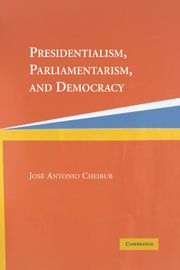Book contents
- Frontmatter
- Contents
- List of Figures and Tables
- Acknowledgments
- 1 INTRODUCTION
- 2 PRESIDENTIAL, PARLIAMENTARY, AND MIXED DEMOCRACIES
- 3 ARE THE INCENTIVES FOR COALITION FORMATION DIFFERENT IN PARLIAMENTARY AND PRESIDENTIAL DEMOCRACIES?
- 4 ARE COALITIONS RARE IN PRESIDENTIAL DEMOCRACIES?
- 5 PARTY DISCIPLINE AND FORM OF GOVERNMENT
- 6 WHAT MAKES PRESIDENTIAL DEMOCRACIES FRAGILE?
- 7 CONCLUSION
- Appendix: Definition and Sources of Variables
- References
- Index
- Cambridge Studies in Comparative Politics
7 - CONCLUSION
Published online by Cambridge University Press: 05 June 2012
- Frontmatter
- Contents
- List of Figures and Tables
- Acknowledgments
- 1 INTRODUCTION
- 2 PRESIDENTIAL, PARLIAMENTARY, AND MIXED DEMOCRACIES
- 3 ARE THE INCENTIVES FOR COALITION FORMATION DIFFERENT IN PARLIAMENTARY AND PRESIDENTIAL DEMOCRACIES?
- 4 ARE COALITIONS RARE IN PRESIDENTIAL DEMOCRACIES?
- 5 PARTY DISCIPLINE AND FORM OF GOVERNMENT
- 6 WHAT MAKES PRESIDENTIAL DEMOCRACIES FRAGILE?
- 7 CONCLUSION
- Appendix: Definition and Sources of Variables
- References
- Index
- Cambridge Studies in Comparative Politics
Summary
We need to put to rest the notion that presidential institutions are not conducive to democratic consolidation. I hope to have shown in the previous chapters that, sensible as it may appear, this notion finds no empirical support in the data. True, presidential democracies are more unstable than parliamentary ones; but this instability is not caused by the incentives generated by presidentialism itself. Presidential democracies die not because the institutions are such that they compel actors to seek extra-constitutional solutions to their conflicts. The conflicts themselves should take some of the blame, since they are probably hard to reconcile under any institutional framework. And given an “activated” military, it is certainly comprehensible why democracies – of any type – should break down into authoritarian systems.
If this is the case, then we are in a position to shift the emphasis of current thinking about political reforms in presidential democracies. As we have seen, much of the literature about democratic forms of government has focused on the relationship between the government and the legislature and the alleged implications of the ways in which this relationship is organized: conflict under presidentialism and cooperation under parliamentarism. This book should make it apparent that these consequences have been at least exaggerated and that differences in interbranch relationships across the two systems are more of degree than of quality.
- Type
- Chapter
- Information
- Presidentialism, Parliamentarism, and Democracy , pp. 165 - 174Publisher: Cambridge University PressPrint publication year: 2006

